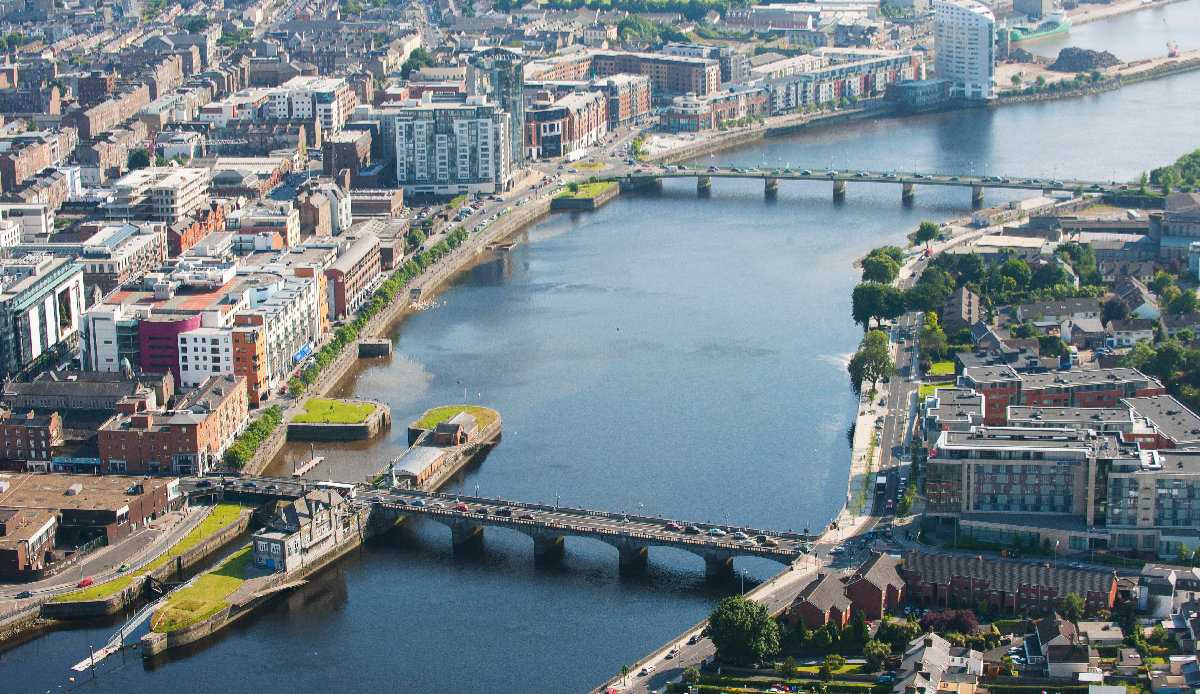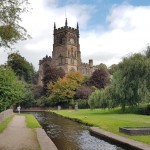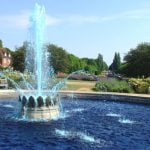
Limerick The Irish city so awesome they went and named a poem after it! Or was it the other way round?
We bet the people that live there are pig-sick of having to search for Limerick (the town) instead of the poetry form. You can find the said city in the mid-west of Ireland, spanning the river Shannon and sharing the Munster province with a few other counties and representing a county, as well as a city. Nearly 100,000 people call the city of Limerick home.
We wanted to take the Five Minutes Spare glance over Limerick to see what this lyrical city has to offer. Poetry aside, what attractions will you find in Limerick? Let’s find out!

Arial View Of The Shannon Running through Limerick.
Image: Diarmuid Greene/Shutterstock.com
The Early Days of Limerick
The ancient, dusty heart of the city can actually be found on the island in the centre of the River Shannon. The reason for this? It has its origins in Viking sensibilities. They always chose their forts based on how defensible the area was. Since they also needed to be on waterways, just about every large island in Ireland and the neighbouring countries made a good Viking haven.
Some sources put Limerick as a Viking settlement founded in 922 AD… which is really specific and doesn’t come with much backup. Since the island (known as King’s Island nowadays) was called Ghaill Duibh before the Vikings arrived, and since the city itself was first recorded in 812 AD, this blows the 922 AD guess out of the water. Further to this, the whole area around the Shannon entrance has been settled since at least 150 AD. When the first map of Ireland was ever made, the area had a town called Regia… ‘belonging to the King’. In 434 St. Patrick came to the island to crown a king…
Other sources mark the presence of Stone Age tombs in Duntryleague from around 3500 BC. The Celts wouldn’t have got here until 400 BC, but there were already stone circles at Lough Gur when they got here. Archaeological dating has put these at 3000 BC. Basically, Limerick is older than sliced bread, older than woven fabrics, and possibly even older than the wheel.
The Vikings sailed up the River Shannon around 812, setting fire to the monastery that existed there in light of St Patrick’s visit. They would have pillaged and burned everything that wasn’t stone, then they would have occupied the city and used it as a base to raid into the surrounding area. Back then, Limerick was a town in County Clare, a region known to have had several Irish Kings in its history.
The Normans Arrive
In 1195 the Normans crossed the sea. By this point, the population of Limerick would have been mixed between Irish natives and Norse blood. The Normans added some DNA to the pot but mostly just repeated the looting and burning. In the same century St. Mary’s Cathedral was erected and still stands to this day as the oldest known building in the area. The Normans invaded under King John I of England’s name, erected a castle on his behalf and instated a ruling system which saw the English with a lot more influence over it than some would have liked.
This control was fully relinquished in 1413 by Henry V. He granted them their own charter which allowed more than the usual. Normally, a first charter would allow a ruling committee to establish paving on the streets and to have them cleaned. Ordinarily, this would be followed a hundred years or so down the line with permission to have a market. Limerick were made a largely independent city state in one fell swoop of the quill.
The 16th century saw this region go to war with Galway, it ended in a peace treaty. King Henry VIII decided he wanted a divorce, closed, and barred all of the monasteries in Ireland, and paved the way for thousands of years of Catholic/Protestant fighting. In 1603 England took its first full grip on Ireland, owning most of it. It was a busy century, since the European wars of the time saw Limerick made into an International stage. The Catholics were hounded out of a multitude of Irish cities by the end of the century. The Williamite War was ended in 1690 as long as the Catholics agreed to swear fealty to William and Mary, over King Charles. The peace treaty was signed on a stone which you can still visit at Clancy Stand.
Let’s take a historical breather and look at some fun stuff. What sort of interesting things have happened here? What’s fun about Limerick? Let’s find out!
Fun Facts about Limerick
This little Munster city has loads on display, some of it incredibly interesting. Here are the Five Minutes Spare favourite fun facts about Limerick, for those that call it home!
- Charles Dickens stopped in for a visit in 1858 only to call it the oddest place he had been to. He believed that nobody outside of Limerick knew anything about the inside of Limerick… except he said it much better than that.
- William Wordsworth also stayed here, but all he had to say was that it was raining a lot. Poetic.
- Limerick once declared itself a Soviet, for 12 days in 1919. While the war of Independence raged around them, the strike was a protest against the British using it as a military operational area.
- Two nicknames for Limerick include the City of Sieges, after being laid waste to several times during the early 17th century, and the Treaty City, since the peace treaty that saw William of Orange make peace with the Catholics was signed here.
- Limerick is home to one of the longest bridges in Ireland. The Living Bridge is so long you can walk it all the way from the University grounds, across the River, and down into Co. Clare[i].
Now that we are all suitably refreshed, let’s jump back in sometime around the 17th century. Limerick was a big place growing larger, and it hadn’t stopped growing yet.
Limerick a Little Later
So after the four sieges (that’s 1642, 1651, 1690 and 1691) the treaty was signed, and everyone supposedly moved on. The following hundred years or so were very much an economic and social recovery for the city. So many sieges and so much war led to bad feeling. Many of the Catholics still in the city lived in terrible poverty. The city finally had some economic success in the Georgian period which saw a bit more investment in the area. At the end of the 18th century the city was an important site to the British government. They shipped all the convicts off to Australia from their port. There was a boom in employment and a turnaround in living conditions. Limerick Port was especially busy and opened the city (and the County) up to the rest of the world. Their main export at this time would have been freshly grown produce.
When the city expanded during this time it took on the familiar, Georgian-style street formations. Terraces and townhouses replaced tenement-style flats or smaller buildings. To this day, much of the city still has a distinctly Georgian feel to it. It makes for a pretty city and a nice place to spend your days off.
During the Great Hunger, the city of Limerick wasn’t that badly hit by starvation. The county dropped by about 20% population overall, but a lot of this would have been immigration. With easy access to the ocean, it would have been far more tempting to jump on a vessel headed to the new world than it would have been to starve and die. East Limerick fared better than the city and the west simply due to crowding. Again, since the Catholic families still suffered from the most poverty, as a general rule of thumb they were hit a little harder by the famine.
Following another ‘substantial’ emigration to Australia, the population of Limerick actually started to drop further. Nevertheless, the city still played a major role in the Easter Rising, almost a hundred years later. In 1848 the railway reached the city as a stop between Dublin and Cork. Unfortunately, instead of starting the 20th century with the boom brought on by new expansion in industry – the Irish were hot on the heels of a huge famine that killed somewhere between 1 and 2.5 million people. They were not swift to recover.
Limerick’s Modern History
The Limerick Boycott preceded the Easter Rising and resulted in the Jews now being hounded from the city. It began in 1904 at the bequest of a Redemptorist Priest. It was all a bit hateful and unnecessary. After the Easter Rising, Limerick was a Soviet state for a few days, it also had huge problems with the Black and Tans. In 1921 two of the city’s mayors were shot dead. In 1922 it was besieged for the final time (to date).
In 1942 the airport was opened, in 1989 the University was finally announced as a growth from the NIHE Limerick, the former further education establishment in the city.
Asides from this, a voluntary contribution to two World Wars, and involvement in the political turmoil characteristic of any Irish city – Limerick is a steadily thriving place. It is well established, with a long history of rising from its own ashes… and sometimes literally. It has been a place of economic recession since the decline of most industrial practices in the early 20th century. Retail and entertainment fought to fill the gap – but if nobody has any spare cash then these sectors will never be huge.
Nowadays, Limerick is a city that benefits from its waterways, its marketplaces, and its sports teams. We like to think that it is a more tolerant, less violent place than it has been in the past. We also like to think about how much growth it has to look forward to, in the coming years. The city that has its dusty heart on an island in the River Shannon is rooted in Georgian décor and revered for its ability to withstand a good siege. Who knows? Maybe the next step for Limerick is to expand those walls for the next round? Only time will tell.
Famous People from Limerick
As well as having been graced by visits from the likes of Charles Dickens and William Wordsworth, Limerick has been home to a fair few famous people. Some of the best known, or at least some of the quirkiest, are as follows:
- Frank McCourt, the man who originally wrote Angela’s Ashes, was a Limerick man.
- Jimmy Carr – yes, the exceptionally English sounding one from the telly – is from Limerick.
- Half of the Cranberries, the 90’s pop group, were Limerick born.
- Famous painter Sean Keating…
- Terry Wogan is also from Limerick! Who would have thought…?
- Football player Tom Aherne, Hurler Richie Bennis, Rugby player Keith Earls… the list of sports people is incredible.
- Richard Harris – Actor and Director – known for his roles in Jaws, Gladiator and This Sporting Life
There are more famous people from Limerick than we are able to place in one page. You can view the full entry on Wikipedia if you have the time. We don’t want you to go anywhere though – we are about to get to the best bit… the attractions of Limerick!
Limerick Attractions
Limerick is an excellent choice for a holiday destination. It is a particularly great place to visit if we can’t fly abroad this year due to covid-19. It has everything your average Irish citizen needs in order to have a great staycation. We picked the Five Minutes Spare favourite attractions and things to do in Limerick, especially for you.
Historical Attractions and Landmarks
Dominating at least part of the Limerick skyline lies the epic King John’s Castle. That’s right; King John came here, invaded, built a castle in his name, and used it as a residence from time to time. Nowadays it is open to the public and has detailed displays of 800+ years of history… they even have re-enactments if you catch them on the right day.
The next epic historical attraction in Limerick is the Lough Gur Visitor Centre. Now normally we would never tell you to visit a visitor’s centre (they tend to be filled with not much but leaflets) but this one is awe-inspiring. It’s still got a thatched roof, which gives you some idea of commitment! What we love most is that it is the only place in the whole island of Ireland that you can see every age of history traced all the way back to Neolithic times – in a visible format. When we said Limerick was old, we weren’t joking.
Last on our list for the day but by no means least; go and see the treaty stone that the pact to end the Galloway-Limerick war was signed on. It marks a landmark moment in Irish history.
Galleries and Museums
The University of Limerick is a historic sight, a landmark, and general attraction – but it also gives you ample opportunity to learn about the city and the people. Moreover, it is the European Centre for the Study of Hate, something we should all contribute to.
Checkout the Hunt Museum, which is mostly fine art pieces, collected by the Hunt family over the years. They have beautiful gardens and do a lot of educational community work. It is estimated they have over 2,000 pieces. You could stop in and visit the Frank McCourt Museum too but do call ahead to ensure it is open before you go.
It’s no museum officially, but you don’t come and visit Limerick without stopping in on Saint Mary’s Cathedral. This is one of the oldest buildings in the city and definitely the oldest standing religious centre. It’s a landmark too, and it’s still in operation as a Cathedral to this very day… almost 900 years later.
Shopping and Retail
The most famous shopping in town can be found at the Milk Market. This indoor/outdoor market is under a canopy, features some awesome Limerick street food, and is great fun to explore. On a Sunday they have relaxation day, on a Saturday they run a farmer’s market.
Those that want to shop till they drop will also enjoy a trip to the Crescent shopping centre. This place features a cinema and plenty of fast food options. It’s where all the cool kids come to hang out at the weekends. If you find your kid here, make sure you still have your credit card…
Sport and Recreation
Thomond Park Stadium is one of the best sights in town for those that love their rugby. Limerick is considered to be the heart of rugby in Munster and is home to many clubs. Shannon RFC, Bohemian RFC, and Limerick FC all play there. You can visit for a game or a tour.
Those that find Greyhound racing interesting might enjoy a visit to Limerick Greyhound Stadium. This is still a popular sport in Ireland although it does seem to be dying out.
For a bit of recreation time, take the little ones to Dreamland Fun Centre. It’s a soft play/adventure centre that makes for one of the best things to do in Limerick with kids. They can tire themselves out while you enjoy some tea. Perfect.
Outdoor Attractions
One of the top things to do in town is to stop at the Terra Nova Fairy Garden. Obviously, this is aimed at sparking the imagination of little ones – but adults get to enjoy the beautiful, natural world complete with a coffee shop and the odd butterfly.
If you want to be outdoors in the wilds of Ireland then you may prefer the Curraghchase Forest Park. This place has 300+ acres of natural forest for you to explore. It even comes with its own magical toadstools and a caravan and camping park.
If hiking is more your thing, head for the Ballyhoura Walking Trails for the best adventures! Be warned – this is a hard trail that takes around 5 hours. Those that love the Terra Nova gardens might also enjoy Coolwater Garden as an additional place to spot some fairy-tale style water lilies.
Other Things to do in Limerick!
That’s not even the half of it! Limerick is so jam-packed with attractions that we were hard pushed to cover them all. Here are some of the things to do in Limerick that didn’t quite make the list:
- The churches… you could come here on a tour of the churches alone. Choose from St. Joseph’s church, St. Saviour’s Dominican Church, Saint Munchin’s Catholic Church, St. John’s Cathedral, the Redemptorist Church, or Saint Michael’s Church… Did we get them all?
- You will find more shops in Arthur’s Quay Shopping Centre if you couldn’t find what you were looking for in the Crescent.
- Limerick Museum and Limerick City Gallery of Art are worth stopping by.
There’s dozens of other statues, monuments and areas of interest hidden within the layers of Limerick history. We hope you have a great time there, no matter what you get up to.
How to Get There?
So now you are up-to-speed on all things Limerick – but do you know how to get there? If you are following the yellow-brick road you are in the wrong place. Follow our directions instead, you have more chance of getting there in the end.
By Road
Head south and west out of Dublin on the N7 and literally don’t come off it until you have crossed the whole island. You should see signs for Limerick.
By Rail
You are looking for Limerick but watch out for Limerick Junction, which is a different station entirely and is actually all the way in County Tipperary. You know the song about it being a long, long way to Tipperary? Don’t make the same mistake.
By Air
Shannon Airport is the one you are looking for.
By Sea
Head for Port Shannon, or for the mouth of the river, and you can’t miss the astoundingly large city perched on it.
Got Five Minutes?
If you still have time to spare why not plan your next vacation, take up a new hobby, or learn about the legal system? Everything is at your fingertips when you waste time with Five Minutes Spare. What have you got to lose but a few moments? It just might be a wise investment on your behalf.
[i] https://www.irishcentral.com/travel/top-10-interesting-facts-about-county-limerick-photos




